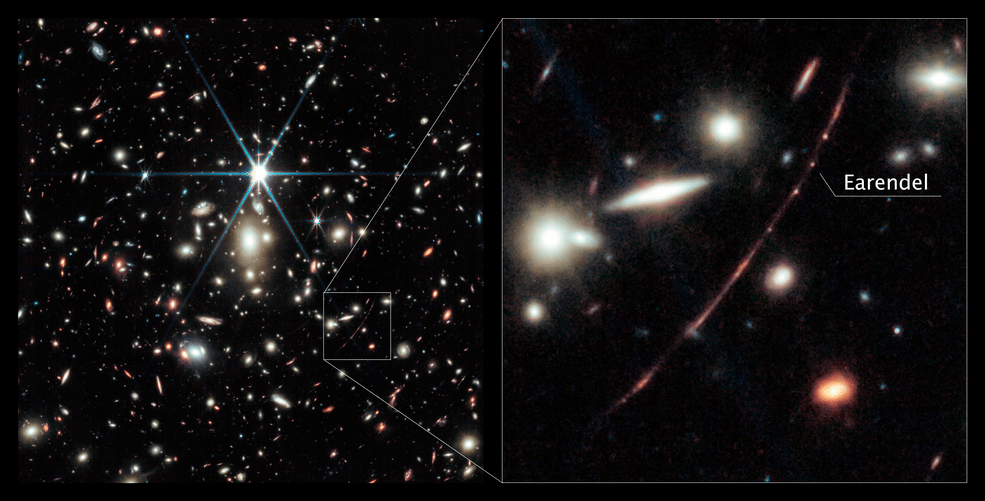Key Takeaways:
- Pioneering Discovery: NASA’s James Webb Space Telescope has uncovered Earendel, the most distant star ever observed, shedding light on the cosmos’ early billion-year history.
- Gravitational Lensing: Through gravitational lensing, Earendel’s detection underscores the symbiosis between human ingenuity and nature’s phenomena, revealing celestial marvels hidden behind spacetime distortions.
- Cosmic Companions: Despite initial expectations, hints of a companion star to Earendel challenge conventional astronomical assumptions, broadening our understanding of stellar formations in the early universe.
- Sunrise Arc Insights: Webb’s NIRCam unveils intricate details within the Sunrise Arc galaxy, offering a glimpse into nascent star formation and the gravitational lens’s distorting effects on celestial landscapes.
- Stellar Physics Frontier: Webb’s discoveries mark a milestone in stellar physics, propelling scientists towards uncovering the universe’s primal stars and redefining the boundaries of cosmic exploration.
NASA’s James Webb Space Telescope has pursued observations made by the Hubble Space Telescope of the most remote star ever discerned in the exceedingly distant cosmos, within the initial billion years post the cosmic cataclysm.
The James Webb Space Telescope, an apex entity in the realm of cosmic observation, has meticulously trailed the observations of the Hubble Space Telescope regarding the farthest celestial entity detected within the unfathomably distant cosmos, within the nascent epoch of a billion years following the celestial explosion.
The ingenious NIRCam (Near-Infrared Camera) instrument, a vital component of the James Webb Space Telescope, unveils the said celestial entity to be an imposing B-type star, surpassing the fervor of our Sun twofold, and radiating luminosity exceeding ours by a millionfold.
This celestial entity, christened Earendel by the diligent research consortium, resides within the Sunrise Arc galaxy, discernible solely through the amalgamated prowess of human ingenuity and natural phenomena, facilitated by a phenomenon known as gravitational lensing. Both the Hubble and Webb telescopes managed to discern Earendel owing to its fortuitous alignment behind a distortion in the spacetime continuum engendered by the colossal galaxy cluster WHL0137-08. This galaxy cluster, positioned betwixt us and Earendel, exerts such titanic gravitational influence that it distorts the very fabric of space, engendering a magnification effect akin to peering through a cosmic magnifying lens.
While other elements within the galaxy manifest multiple appearances due to gravitational lensing, Earendel remains solitary, appearing as a singular point of luminosity even under Webb’s high-resolution infrared scrutiny. Predicated upon this, astronomers ascertain that the entity is magnified by a factor of no less than 4,000, thereby underscoring its diminutive proportions – the most remote star ever perceived, observed merely a billion years post the cosmic explosion. The erstwhile record-holder for remoteness, a star detected by Hubble and observed approximately four billion years post the cosmic genesis, pales in comparison. Another research cadre utilizing Webb recently espied a gravitationally lensed star christened Quyllur, a vermilion giant observed three billion years post the cosmic cataclysm.
Celestial entities as prodigious as Earendel frequently harbor companions. Astronomers harbored no expectation for Webb to unveil any such companions of Earendel, given their proximate nature and indistinguishability in the celestial expanse. Nonetheless, predicated solely upon Earendel’s chromatic profile, astronomers discern vestiges of a cooler, redder companion star. This radiance, elongated by the universe’s expansion to wavelengths beyond the purview of Hubble’s instrumentation, remains discernible solely through Webb’s discerning eye.

Additionally, Webb’s NIRCam divulges other salient features within the Sunrise Arc, constituting the most conspicuously magnified galaxy hitherto detected within the cosmic infancy. These features encompass burgeoning star-forming locales and well-established stellar agglomerations spanning a mere 10 light-years in diameter. Flanking the zenith of maximal magnification, delineated by Earendel, these features are mirrored by the gravitational lens’s distortion. The star-forming region appears elongated, estimated to be no more than five million years of age. Adjacent to Earendel, smaller luminescent entities denote two images of a singular, elder stellar agglomeration, estimated to be no less than ten million years old. Astronomers infer the gravitational cohesion of this stellar agglomeration, suggesting its longevity until the present epoch, thereby offering insights into the appearance of globular clusters within our own Milky Way galaxy some 13 billion years hence.
Astronomers currently pore over data gleaned from Webb’s NIRSpec (Near-Infrared Spectrograph) instrument, dissecting observations of the Sunrise Arc galaxy and Earendel, promising precise assessments of their composition and distance.
Since Hubble’s serendipitous discovery of Earendel, Webb has espied other celestial entities in the farthest reaches of space employing this methodology, albeit none as remote as Earendel. These discoveries have inaugurated a novel frontier in stellar physics and proffer novel avenues for scholars scrutinizing the incunabular cosmos, where once galaxies stood as the smallest perceptible cosmic entities. The research consortium tentatively postulates that this may herald a stride towards the eventual discovery of the primordial generation of stars, forged solely from the elemental crucibles of the cosmic genesis – hydrogen and helium.
The James Webb Space Telescope stands as the preeminent vanguard of space-borne scientific inquiry. Webb, with its discerning gaze, plumbs the enigmas latent within our solar hinterland, peers beyond to distant realms ensconced around alien suns, and probes the enigmatic structures and genesis of our cosmos, elucidating our niche within its vast expanse. Webb constitutes an international collaborative endeavor spearheaded by NASA, in concert with its partners, the ESA (European Space Agency) and the Canadian Space Agency.

